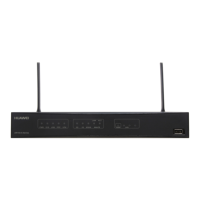l Prefix length: indicates the length of the destination address prefix. From the prefix length,
you can infer that the destination address is a network address or a host address.
l Nexthop: indicates the address of the close next hop through which the packet reaches the
destination.
l Flag(s): identifies route features.
l Interface: indicates the outgoing interface of the packet.
l Timestamp: Indicates the time when an FIB entry is established.
l Tunnel ID: Indicates the ID of VPN Tunnel.
NOTE
The IPv6 function is used with a license. To use the IPv6 function, apply for and purchase the following
license from the Huawei local office:
l AR150&200 Value-Added Data Package
3.3 Configuring an IPv6 Address for an Interface
Assigning an IPv6 address to a device on a network enables the device to communicate with the
other devices on the network.
3.3.1 Establishing the Configuration Task
This section describes the applicable environment, pre-configuration tasks, data preparation, and
configuration procedure for assigning an IPv6 address to an interface.
Applicable Environment
When a device communicates with an IPv6 device, you need to configure IPv6 address for the
interface. The AR150/200 supports configuring IPv6 addresses for the following interfaces:
l Ethernet interfaces and sub-interfaces
l Tunnel interfaces
l Loopback interfaces
l Eth-Trunk interfaces, Eth-Trunk sub-interfaces(support IPv6 only when they work in Layer
3 mode)
l VLANIF interfaces
l VE interfaces
l VT interfaces
You can configure 10 addresses for one interface. Addresses can be the link-local address and
the global unicast address.
The link-local address is used in ND, and in the communication between nodes on the local link
in the stateless address auto-configuration. The packets using the link-local address as the source
or destination address are not forwarded to other links.
The link-local address can be automatically generated or manually configured. After being
enable with automatic address generation capability, the system automatically generates a link-
local address. The link-local address configured manually must be a valid link-local address
(FE80::/10).
Huawei AR150&200 Series Enterprise Routers
Configuration Guide - IP Service 3 Basic IPv6 Configuration
Issue 02 (2012-03-30) Huawei Proprietary and Confidential
Copyright © Huawei Technologies Co., Ltd.
54

